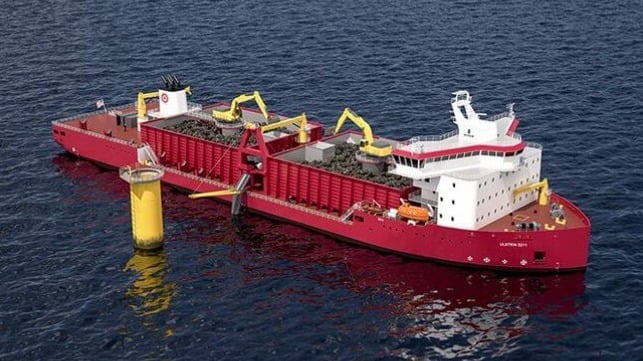Contract Awarded for First U.S. Subsea Rock Vessel for Offshore Wind

Seeking to realize the opportunities emerging in the offshore wind industry, Great Lakes Dredge & Dock Corp. confirmed that it is moving forward with the construction of the first Jones Act compliant subsea rock installation vessel. It represents an expansion for the company, which has been in the dredging industry for more than 130 years, as it seeks a role in the emerging offshore sector.
The contract for the construction of the 461-foot-long vessel went to Philly Shipyard, which like Great Lakes is seeking to diversify its operations after building Jones Act tankers and now beginning work on the new class of training vessels being built for MarAd under a contract with Tote Services. The construction contract for the fallpipe vessel for subsea rock installation is valued at $197 million with the vessel due for delivery in the fourth quarter of 2024. Philly Shipyard also said that it has given Great Lakes a right of first refusal on a second ship, which would be delivered a year later in the fourth quarter of 2025. If Great Lakes proceeds with both vessels the total contract is valued at $382 million.
Great Lakes announced in December 2020 that it was exploring the development of the vessel to meet the opportunities it sees emerging in the offshore wind sector. The basic design is by Ulstein and has been reviewed and approved by the American Bureau of Shipping (ABS). Delivery of the vessel is timed to when they anticipate the first wave of offshore installations will be underway.
“This contract marks a milestone for our company, the U.S. offshore wind industry and our nation,” said Lasse Petterson, Great Lakes Dredge & Dock’s President and Chief Executive Officer. “Offshore wind will play a crucial role in helping the U.S. meet its decarbonization and clean energy goals. The unique, technologically advanced vessel we are constructing is an essential step towards building the marine infrastructure required for this new industry, which holds so much promise for our nation economically and environmentally.”
Among the design features the company is highlighting are best-in-class safety and low emissions standards (LEV, Sustain2), EPA Tier 4 engines and plug-in capability to obtain power from shore while loading. The vessel will be able to run on biofuel and it will be equipped with advanced active emissions control technology to reduce NOx emissions. An installed battery pack will shave peak loads to reduce fuel consumption and emissions.
U.S. regulators have determined that vessels operating in the installation and maintenance of the offshore wind sector will need to comply with the Jones Act cabotage regulations in a fashion similar to the enforcement of the regulations or the U.S. offshore oil and gas sector. Great Lakes highlights that in addition to being the first vessel built in the U.S. for these tasks it will be U.S. owned and operated and manned by a U.S. crew of up to 45 people to be in compliance with the Jones Act. They believe it will also spur additional job growth and regional economic opportunities through the creation of a U.S.-based rock supply chain network, which will be needed to supply subsea rock installation activities, from quarries in states along the East Coast.
The subsea rock installation vessel is designed to carry up to 20,000 MT of rock, transporting and depositing the rocks to the ocean floor. It will lay a foundation for the monopiles which serve as the prevailing support structure for offshore wind turbines.
